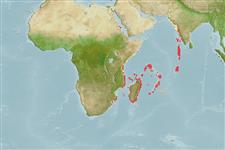分類 / Names
共通名の | 類義語 | Catalog of Fishes(部類, 種) | ITIS | CoL | WoRMS | Cloffa
>
Gobiiformes (Gobies) >
Gobiidae (Gobies) > Gobiinae
Etymology: Eviota: No etymology given, suggested by Christopher Scharpt: from Latin 'eu' for 'true' and 'iota' for anything very small, in combination 'truly very small' referring to it as being the smallest vertebrate at the time it has benn described by Jenkins (thus, making the suggestion by Scharpt plausible.; notata: Named for the large, dark marks on the head and nape (Latin word 'nota' meaning mark)..
Environment: milieu / climate zone / depth range / distribution range
生態学
海 関連する礁; 深さの範囲 0 - 27 m (Ref. 92021). Tropical
Western Indian Ocean: the Seychelles and Amirante Islands; Mauritius, Mascarene Islands, Cargados Carajos Shoals; and the Chagos Archipelago.
サイズ / 重さ / 年齢
Maturity: Lm ? range ? - ? cm
Max length : 1.5 cm SL オス/雌雄の選別がない; (Ref. 92021)
簡単な記述
検索表 | 形態学 | 形態計測学
背面の脊椎 (合計) : 7; 背鰭 (合計) : 6 - 7; 肛門の骨: 1; 臀鰭: 6 - 7; 脊つい: 26. This species is distinguished from its congeners by the following characters: nape with a series of 3 prominent dark transverse marks, the first 2 of which are separated into enlarged spots dorsolaterally; dorsal to anal fin-ray formula 7/7; complete cephalic sensory pore system; pectoral-fin rays 10-14 always branched; first dorsal fin not elongate (Ref. 92021).
Life cycle and mating behavior
Maturities | 繁殖 | Spawnings | Egg(s) | Fecundities | 幼生
Greenfield, D.W. and S.L. Jewett, 2012. Two new gobiid fishes of the genus Eviota from the Indian Ocean (Teleostei: Gobiidae). Zootaxa 3515:67-74. (Ref. 92021)
Human uses
用具
特記事項
XMLをダウンロードして下さい
インターネットの情報源
Estimates based on models
Preferred temperature (Ref.
123201): 25 - 28.9, mean 27.4 °C (based on 331 cells).
Phylogenetic diversity index (Ref.
82804): PD
50 = 0.5000 [Uniqueness, from 0.5 = low to 2.0 = high].
Bayesian length-weight: a=0.01023 (0.00477 - 0.02194), b=3.02 (2.84 - 3.20), in cm total length, based on LWR estimates for this (Sub)family-body shape (Ref.
93245).
栄養段階 (Ref.
69278): 3.0 ±0.3 se; based on size and trophs of closest relatives
Fishing Vulnerability (Ref.
59153): Low vulnerability (10 of 100).
